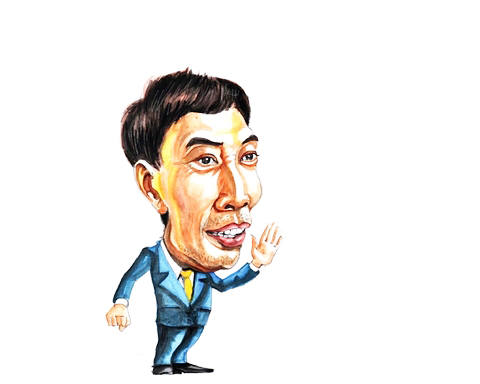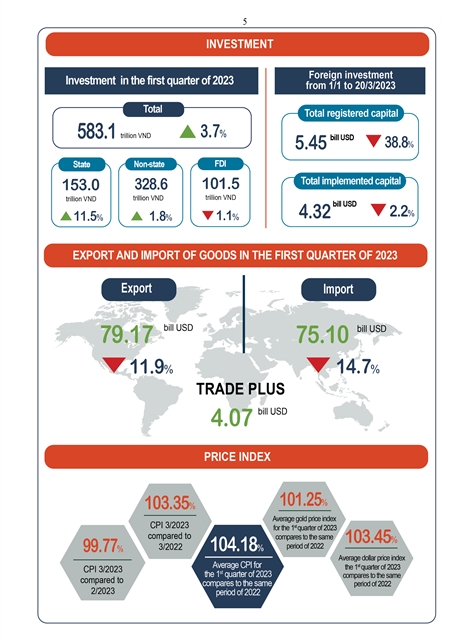Việt Nam's economic recovery remains bumpy in Q1 2023
The latest data from the General Statistics Office (GSO has shown Việt Nam's economic recovery remains bumpy, putting pressure on upcoming quarters to achieve the Government's socio-economic goals for the year.
Võ Trí Thành |
Võ Trí Thành
The latest data from the General Statistics Office (GSO has shown Việt Nam's economic recovery remains bumpy, putting pressure on upcoming quarters to achieve the Government's socio-economic goals for the year.
The socio-economic climate in the first quarter of 2023 occurred amid a world economy fraught with complex fluctuations and instability. While global inflation has somewhat abated, it remains high, and the fluctuations in consumption demand of key trading partners are still affecting the Vietnamese economy. Moreover, the bankruptcy of certain banks in the United States and Europe has caused a dent in people's trust in the banking system, while central banks persist in implementing tight monetary policies.
Economists had predicted since late 2022 that Việt Nam’s economy would face two external headwinds in 2023. The first is the decline of the world economy, particularly the risk of economic recession in some of Việt Nam's major trading and investment partners. The second is the monetary tightening of many central banks due to persistent high inflation.
The Vietnamese economy itself still faces many challenges, including financial and monetary problems, macro variables such as inflation, bank liquidity, cash flow, exchange rates, interest rates and the real estate market. The Government is working to address these issues.
The obstacles and hurdles were, in part, evident in the statistics from the end of 2022 and more visibly in the first quarter of 2023.
The economy recorded a growth rate of 3.32 per cent in Q1, considerably below the projected target of 5.6 per cent outlined in Resolution 01/NQ-CP dated January 6, 2023, and nearly the lowest in the last thirteen years.
The decline in the production of some key industries caused the added value of the whole industry in the first quarter to decrease by 0.82 per cent year-on-year. Besides, the languid progress in industrial production and sluggish growth in some regions and provinces, including HCM City, that significantly contribute to Việt Nam's economic development, are worrisome. The HCM City’s Gross Regional Domestic Product (GRDP) in the first quarter only expanded by a meager 0.7 per cent.
Việt Nam's import and export turnover of goods also weakened. Although there was still a trade surplus of more than US$4 billion in the first quarter, the total export and import turnover of goods was estimated at $154.3 billion, down 13.3 per cent over the same period last year, of which exports decreased by 11.9 per cent and imports decreased by 14.7 per cent.
Total foreign investment as of March 20, 2023, including newly registered capital, adjusted registered capital, and the value of capital contribution and share purchase by foreign investors, reached $5.45 billion, down 38.8 per cent over the same period last year.
There are still a few exceptional areas of growth in retail and consumption. In Q1 2023, the overall revenue from retail sales of consumer goods and services is estimated at VNĐ1.5 quadrillion ($63.8 billion), representing a notable uptick of 13.9 per cent compared to last year’s same period.
The 2023 economic growth target of 6.5 per cent is considered extremely challenging.
 |
|
Infographics show macro-economic indicators of Việt Nam in the Q1 2023. VNA/VNS Photo |
Recently, a number of international organisations have lowered their GDP growth forecasts for Việt Nam in 2023. For example, Singapore-based United Overseas Bank (UOB) has lowered its growth forecast for Việt Nam from 6.6 per cent to 6 per cent, and the World Bank has also lowered its forecast from 6.7 per cent to 6.3 per cent.
In this context, Việt Nam needs to focus on three issues to minimise adverse impacts.
Firstly, Việt Nam should take advantage of opportunities arising from the global economic situation being less difficult than expected. The crisis and recession risks have been gradually reduced in some countries.
Recently, the International Monetary Fund (IMF) raised its 2023 growth forecast for global economy to 2.9 per cent from 2.7 per cent. Fitch Ratings (FR) has revised its forecast made in December 2022 by adding 0.6 percentage points to global growth rate to 2 per cent in 2023. The Organisation for Economic Cooperation and Development (OECD) has forecasted a growth rate of 2.6 per cent, an increase of 0.4 percentage points compared to November 2022.
Despite inflation still being uncertain this year, it is expected to have passed its peak, and the interest rate hike of some central banks, including the Fed, will be less “hawkish”. China is also considered one of the few countries where growth will be better this year.
Secondly, Việt Nam needs to address financial and monetary issues, and the Government and businesses must work together to achieve this. Recently, liquidity in the banking system has improved, the central bank started to buy foreign currencies and inflation stayed at an acceptable level, with a rate of 4.18 per cent in the first quarter.
Interest rates have started to drop slightly, contributing to stabilising the macro-economy, particularly with policies and plans issued recently to solve bottlenecks in the bond and real estate markets such as Decree 08 and the credit package of VNĐ120 trillion for real estate firms.
In addition, the State Bank of Việt Nam (SBV) decided to cut some policy interest rates from April 3, its second time this year, to support the economy.
Thirdly, the public investment sector is flourishing, and it is expected to serve as the backbone of the economy this year. Since the start of the year, the realised investment capital in the State sector has surged by 11.5 per cent, underscoring the Government, ministries, and localities' efforts in implementing swift and decisive actions to expedite public capital disbursement from the outset of the year. This impetus is poised to propel the short- and long-term economic growth.
Furthermore, the Government's post-pandemic recovery support programme for businesses has continued to be adjusted and has produced many positive results. Việt Nam also needs to diversify its markets to minimise negative effects on exports and increase foreign direct investment (FDI) attraction.
Việt Nam is still a favourite investment destination for other foreign investors, and recently, a US delegation came to explore investment opportunities in Việt Nam. The challenge now is to convert this interest into actual commitment.
If Việt Nam can take advantage of the favourable external factors and domestic efforts, it can maintain a positive growth rate this quarter. However, in addition to immediate actions, Việt Nam still needs to continue pushing forward reform and development associated with new trends to keep up with the world and develop sustainably.
Võ Trí Thành is a senior economist at the Central Institute for Economic Management (CIEM) and a member of the National Financial and Monetary Policy Advisory Council. A doctorate in economics from the Australian National University, Thanh mainly undertakes research and provides consultation on issues related to macroeconomic policies, trade liberalisation and international economic integration. Other areas of interest include institutional reforms and financial systems. He authors Việt Nam News column Analyst’s Pick.








